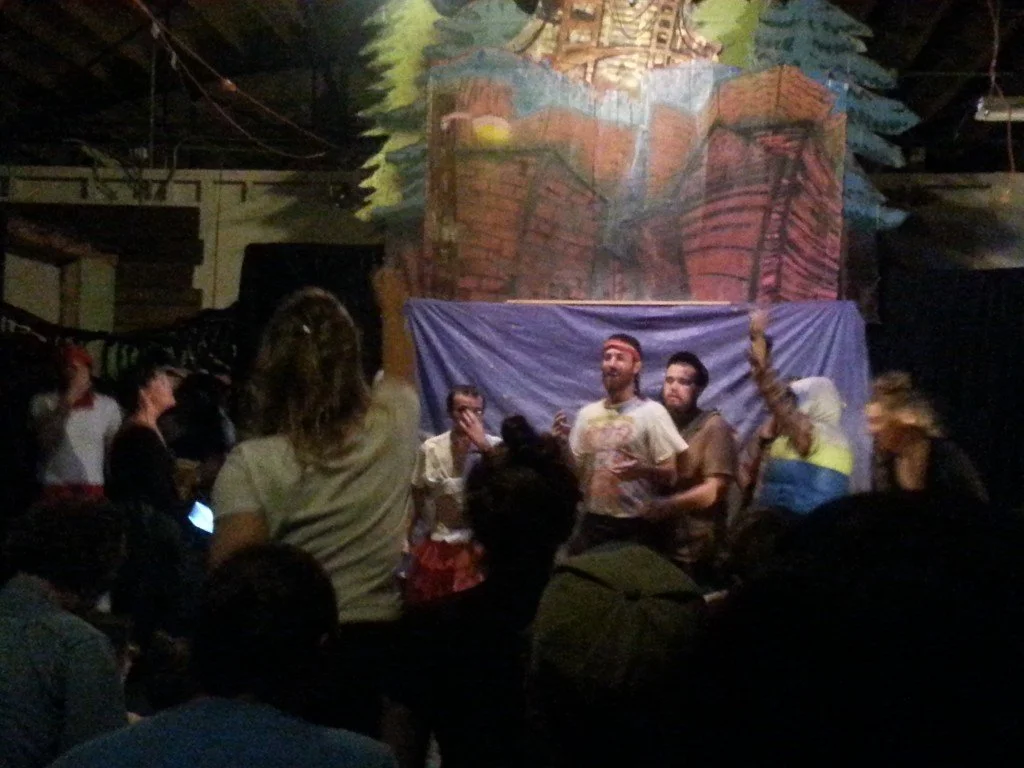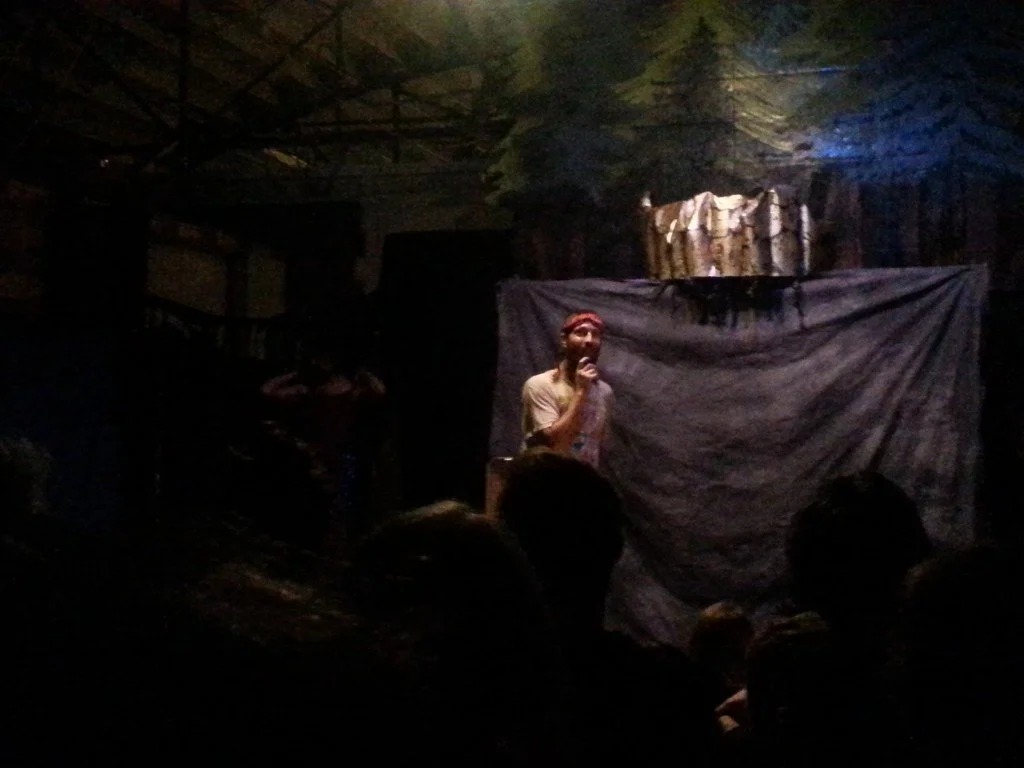The “Hole” Between Artifact and Viewer
A few weeks ago, I had lunch with local artist Judith Levy. Having freshly come back from the
east coast (her- a residency at Art Omi; and myself- showing curated work in New England),
Levy asked me “what is the most interesting art you have seen in Kansas City?” I
immediately responded with “Mel’s Hole.” While the play wasn’t shown at the typical
alternative-theatre venues, or in the crossroads (Shown at Hoop Dog Studios), I found the
project rich in multiple artistic and aesthetic histories; recalling various theatrical types,
which, in turn, enabled a unique development of creative live exploration that, for me,
rendered itself far more interesting than most work I have seen recently.
Mel’s Hole is a collaborative project, which fully materialized through a collective process, as
cast members and musicians performed during a weekend-long production at the beginning
of August. The play, loosely based off of a phone call in 1997 from a man named Mel Waters
on the radio program Coast to Coast A.M. with Art Bell, was a combination of Brechtian
theatre, Hedwig, fantasy, slapstick, and sincerity. The play envisions life outside and inside
the “hole,” while government agents function as the antagonists to Mel. The characters
inside the hole are fragments and collections of objects thrown into the hole over the years,
and when one of them, a seal played by Flora Mahaffy, “crosses over” – complications ensue
among the creatures’ interpersonal relationships, finally culminating in a comedic, dramatic
decision by Mel.
The overall composition embraced multi-layered artistic strategies that could be appealing to
families as well as contemporary Brecht-seekers, such as myself. While I don’t always agree
with the idea that aesthetic content ought to be “available” to families as well as critics, Mel’s
Hole showcased a capacity to embody an enrapturing experience for the viewer, without
over-saturation to a point of rendering the viewer numb. This experience was made possible
through a musical exposing its workings rather than working toward mindless, glossy
consumerism. While costumes were vibrant and riveting, each costume erred on the side of
gaudy, instead of opulent, that revealed physical visual work done by actors instead of the
aristocracy. However, to say it was charming would be to, in my opinion, belittle the
production. Instead, it was funny, warm, and inclusive. While still located within the
proscenium arch, Mel’s Hole retained an ability to reach out to viewers, to develop a third
space between stage and audience. And, while arguably, this third space is achieved
anytime a live or aesthetic work is produced; sometimes this space is more developed, more
nuanced than others. It is through this collective energy that I found homage to Brecht, to a
kind of theatrical and artistic space that asks the audience to think, though not through
ostentatious visual and physical means.
Having seen several Brecht productions, both at the college and professional level, I do not
believe I have witnessed a particular core of what Brechtian theatre gave contemporary art:
the meta-space as a space of criticality, momentum and productivity. Often, Brecht theatre
undergoes the same slick treatment as other types of productions. (For example, in an
“experimental” production ofThe Jungle in Boston, 2011, the set design remained new,
calculated, and austere.) The meta-space that Brecht pushed in his writings and plays
functioned as a location for critical dialogue to occur. With the meta-space/text/feeling/affect,
the audience could develop a type of cognitivedissonance with the aesthetic material in front
of them. Through this dissonance, the audience may generate a more critical eye by which to
examine other types of social, cultural, and political spaces, ultimately leading to changes in
society. Whether or not his goals and ideas found fruition is up for debate; however,
Brechtian meta-space has provided a frame and fuel by which one may generate and
unpack artwork. The Brechtain lens provides particularized strategies, which have the
potential to engender moments of (in his understanding, politically-charged) consumptive
clarity for the viewer.
This aesthetic produces acting techniques that simultaneously showcase the character
portrayed and actor playing the character, costume and set design that reveals its own
generative process, and music as a dismantling force within the Diegesis. In art, we see
these strategies through tongue-in-cheek art historical reference, satire, and viewer
acknowledgement. Visual composition, aesthetic technique, audience participation, and
materiality are all ways in which the meta-space/third space of the Brechtain form is
rendered. It is here I find overlap between live and mediated artwork. Mel’s Hole was, in my
opinion, both an incredible piece of theatre as well as fine art.Additionally the play
succeeded as public comedy, physical theatre, performance art, dance, and music. Clever,
curious, bizarre – but never pretentious –Mel’s Hole occupied a rare space among
contemporary culture.
During intermission, while speaking to other audience members, weall felt immensely
motivated to create. Yet, not in a way that emerged from a sense of lack: one’s own personal
production, of textbook knowledge, of talent, etc.; but from a motivation possessed through
a collective understanding that creative work can happen, and that there is a space, place,
and community in which the work may happen. In Kansas City, and elsewhere I imagine, this
type and quality of motivation is exceptional. This resulting affect, for me, absolutely
positions Mel’s Hole as one of the more interesting events I have experienced in Kansas City.
* List of cast/crew/musicians/special thanks
Nick Begley
Andy Cullen
Party Ron
Aaron Esala
Sean Eagan
Daniel ‘DJ’ Frick
Matt Gladson
Lindsey Griffith
Samarah Hagagi
Suzanne Hogan
Bri Shay
Flora Mahaffy
Christopher Trailer
Danica Wilson
6 Mil
Evan Malone
Suzanne Hogan
Danny Fischer
Nick Begley
Charlie Mylie
Danny Perelman
Jacque Griffith
Aurora Kettering
Zack Herrmann
Timmy Put
Jon Kraft
Lori and Kathy





